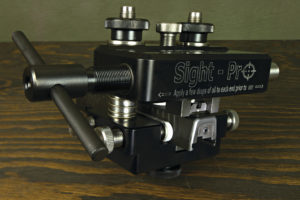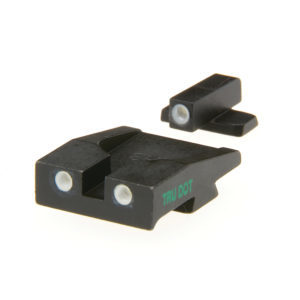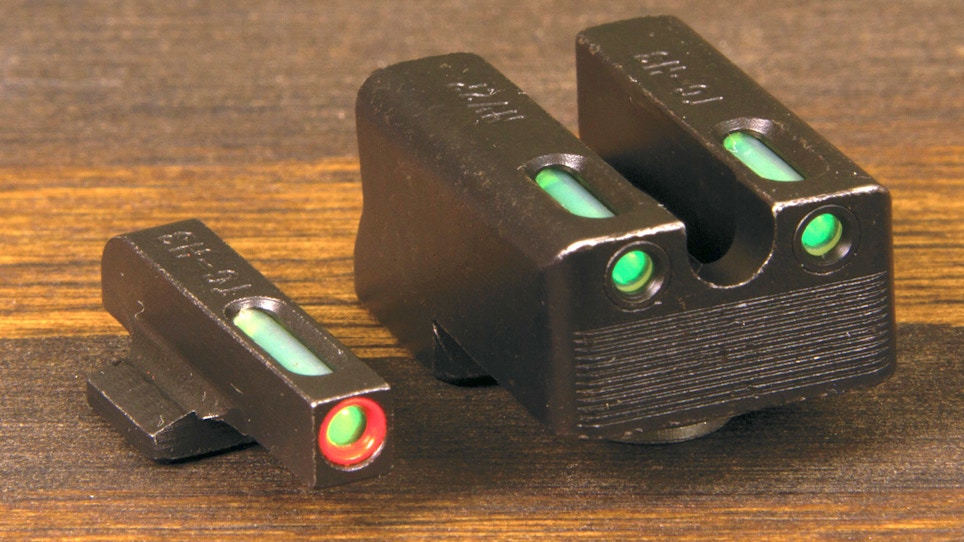Truglo enhanced the TFX series of night sights by adding an orange ring to the front sight. These TFX Pro sights are bright during the day and when it is dark. (Photo: Doug Larson)
For accurate handgun shooting, sights are important, especially for precision shots. But to use those sights, you have to see them.
Since most self defense shootings occur in diminished light, sights are often hard to see. Optical fiber and gold or brass bead front sights help by concentrating light from external sources, but now we have something better — tritium night sights. These sights glow in the dark without the need for an external light or power source and do not need to be charged with an external light. They glow on their own for years, and they glow all the time, so are instantly ready for use the second the gun is needed.
Smart retailers are able to increase sales by explaining to customers the benefits tritium night sights offer.
Tritium is a radioactive isotope with the symbol H3 and consists of three atoms of the element hydrogen. While small amounts are found naturally in the environment and in ground water, the manmade H3 used in night sights is produced in nuclear reactors or high-energy accelerators. The radiation emitted by tritium does not travel far in air and cannot penetrate human skin.
Tritium's half life is about 12 years. In other words, after about 12 years, tritium emits only half the radiation it emitted when it was new. And at that point, tritium night sights may still glow, but they have become so dim that they are not very useful.
Tritium Night Sights
Brand-new night sights glow all the time, although in normal room lighting or sunlight, the glow is too dim to be easily seen. When environmental light dims though, tritium sights become visible, although it's not really the tritium that glows. Actually, it's a chemical mixed with the tritium and contained in a glass vial that glows when subjected to tritium's radiation.
Trijicon is a well known manufacturer of tritium night sights and installs vials for many other sight makers. Traditional Trijicon night sights use the three dot pattern and are available for a wide variety of guns. (Photo: Doug Larson)
Tritium is highly regulated in the United States by the Nuclear Regulatory Commission (NRC), so only a few companies actually install vials of tritium. Trijicon, for example, has the proper licenses so it installs tritium vials in the night sights made and sold by many other makers.
Some makers contacted for this article were a bit tight lipped about where they obtain tritium or tritium vials. Even Trijicon would say only that, "Trijicon night sights are manufactured in America at our facility in Wixom, Michigan." The spokesman went on to say, "Trijicon sources tritium from a leading supplier of tritium, known for their quality controls."
One maker, Heinie Specialty Products, gets vials from Trijicon for use in its sights and another, Truglo, says it gets its H3 from Switzerland. Novak Designs gets its vials from MB Microtec and then has the vials installed in its sights by Trijicon. MB Microtec of Switzerland makes tritium vials in red, orange, yellow, violet, white, green, light blue and dark blue. Its warranty is 10 years.
Installation and Stimulation
To stimulate sales, some retailers offer free installation of night sights bought at their store, and they point out that the customer can replace regular iron sights on not only pistols that have been owned by the customer for some time, but also new purchases. Removing sights and replacing them with tritium night sights must not always be done by a gunsmith, but it does require some skill and tools. Whoever does the installation should also have the knowledge, skills and confidence necessary to do the job properly, or the retailer could have an expensive problem to solve.
Some sights, even ones that are sold as direct replacements, may need minor fitting. And fitting the right way requires certain tools including dovetail files with the correct dovetail angle and with teeth on only one of three sides. These and other tools can be obtained from Brownells (www.brownells.com).

Sight pushers can be a great help in mounting sights. This Sight Pro by MGW holds a variety of handgun slides firmly while the sights are moved in dovetail cuts. It is available from Brownells (www.brownells.com). (Photo: Doug Larson)
Sometimes if a direct replacement sight is not available, a new dovetail will need to be cut into a gun's slide. Cutting dovetails is something best left to a qualified gunsmith who has experience and the proper tools. But whether a retailer uses a gunsmith or some other qualified individual to install sights, the retailer must be sure the person making the installation knows what he is doing.
Not everyone installs sights the same way. For example, TruGlo recommends using a sight pusher and offers a special deal to retailers for the purchase of an MGW Sight Pro. On the other hand, Novak Design president Charley Pulit dislikes sight pushers and thinks sights should be removed and installed with a hammer and drift. But he cautions, the sight must be driven by applying force to the dovetail and not the blade, because striking the blade can easily break a tritium vial. If a hammer and drift are used, the drift should be made of brass, aluminum or nylon, and the installer must use caution.
There are a number of sight pushers available from Brownells. Two examples are the MGW Sight Pro mentioned earlier and the B&J Machine P500 Pro Universal Sight Tool. Both work with a wide variety of sights and gun models.
The MGW Sight Pro requires a shoe that fits inside the slide rails to support the slide. There are 39 different slide shoes currently listed on the Brownells website and they are priced at around $18 each. The B&J Machine P500 Pro Universal Sight Tool does not require additional parts to fit different guns and can also be adjusted to push on the dovetail of the front sight, not just the blade as is the case with the Sight Pro. Brownells lists the P500 for about $275 and the Sight Pro for about $350. Incidentally, B&J is close to introducing a new and improved version of its P500.
Sights
There are many direct replacement tritium night sights available for a wide variety of handguns, and each has a different feature or two that will appeal to customers. Some tritium night sights are listed below in alphabetical order.
Heinie Specialty Products: Richard Heinie is a custom gun maker with his own line of handgun sights. His tritium night sights are offered with several size dovetails for a number of popular pistols. The tritium warranty is 10 years, and he uses only green tritium vials. Making his sights a bit different is the dot-over-dot configuration which he calls the Straight Eight design. When the front dot is properly positioned above the single rear dot, the image resembles an eight. Heinie says that this is less confusing for the eye, making sight acquisition quicker than with traditional three dot sights. He says the human eye naturally aligns things faster vertically than horizontally. (www.heinie.com)

These Tru-Dot Night Sights from Meprolight are made in Israel and according to Meprolight, are the brightest tritium night sights available. (Meprolight image)
Meprolight: Meprolight is an Israeli company represented in the U.S. by The Mako Group. Meprolight uses Swiss-made tritium vials in the manufacture of its night sights which come in green, yellow or orange. The sights are available for a variety of popular handguns and have a 12-year warranty on the tritium vials. Meprolight represents that its sights are the brightest sights on the market and recommends that installation be made with a sight pusher. (www.meprolight.com and www.themakogroup.com)
Novak Designs: Wayne Novak built a stellar reputation as a gunsmith making custom guns. He also developed a line of handgun sights that have an equally great reputation and have been adopted by a number of gun makers as original equipment. Genuine Novak sights are so popular that they are frequently copied. Novak Designs, in addition to many non-illuminated iron sights ranging from plain-black-to-white dot, fiber optic and gold or brass bead, makes tritium night sights for a number of different handguns. The classic Novak LoMount sight can be had with a tritium bar or with tritium dots in a fixed, or Novak's new adjustable, rear sight. A variety of rear notches are also available, and Novak offers installation services. (www.novaksights.com)
Trijicon: According to a spokesman, Trijicon does the vast majority of tritium installations for the firearms industry, and uses exclusively green tritium vials for its front sight because that is the color most easily seen by the human eye. Rear sights can be obtained with green, orange or yellow tritium vials. Trijicon offers a 12-year warranty on the tritium in its green and yellow sights, but only five years on orange sights. Although the tritium in a vial cannot be recharged or replaced, Trijicon offers to replace tritium vials in old sights for a fee. (www.trijicon.com)
Truglo: Truglo manufactures its night sights in Richardson, Texas, with tritium obtained from Swiss sources. It uses green vials because green is the easiest seen by the human eye, although its popular TFO (Tritium Fiber Optic) series of sights can be obtained with a green front and yellow rear three dot configuration. The company's limited warranty is 12 years. The TFO and TFX lines are particularly interesting because they combine popular fiber optics with tritium vials causing the sights to glow brightly not only in low light conditions, but also in bright sunlight. They are very good at drawing the eye in any light condition. (www.truglo.com)
XS Sights: XS Sights makes a number of tritium night sights in its Standard and Big Dot configuration, but has just added its F8 Night Sights to the line. The orange ring around the front tritium vial is of a shade of orange that is more easily seen by the human eye than other shades of orange. The ring also is photo luminescent causing it to glow brightly after charging with ambient light. This allows the eye time to adjust and make the transition from bright sunlight to a dark room where the dimmer glow of the tritium is visible. The rear sight is also serrated to reduce glare. With a 10-year warranty, the F8 sports the dot-over-dot configuration which some say reduces the chances of placing the front dot of a three dot system to the outside of the rear sight causing a severe misalignment. (www.xssights.com)
People see things differently and a sight that works for one person may not be the best choice for another. Rear notch configuration, including U or square, and width can be important to some customers and not others. Some will like three dots and others will prefer dot-over-dot or dot-over-bar. And some will like the TFO or TFX line from TruGlo that combines optical fiber technology with tritium vials; others will hate them because the dots glow too brightly and can interfere with obtaining a proper sight picture.
So present the options and let your customer decide what sights are right.




